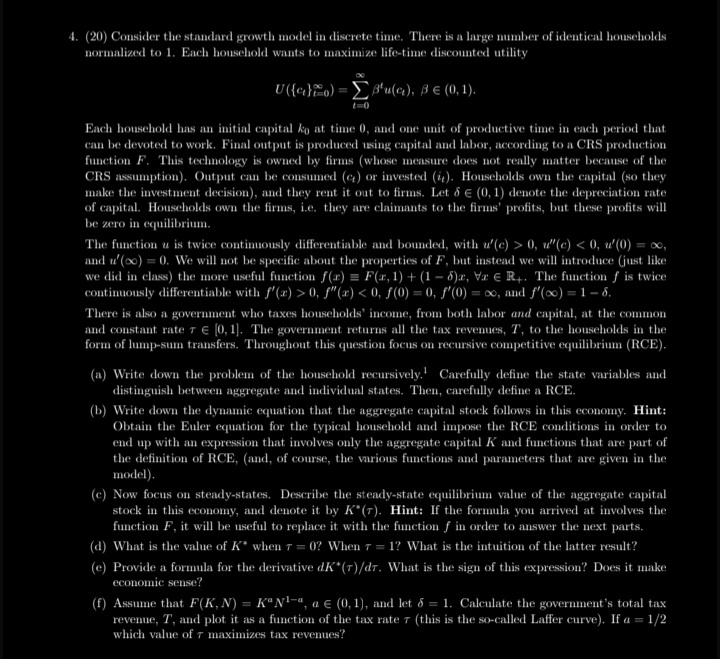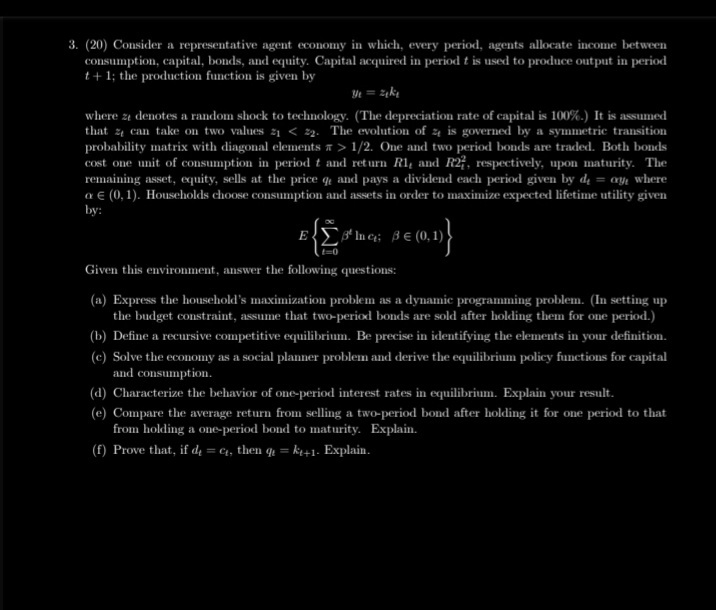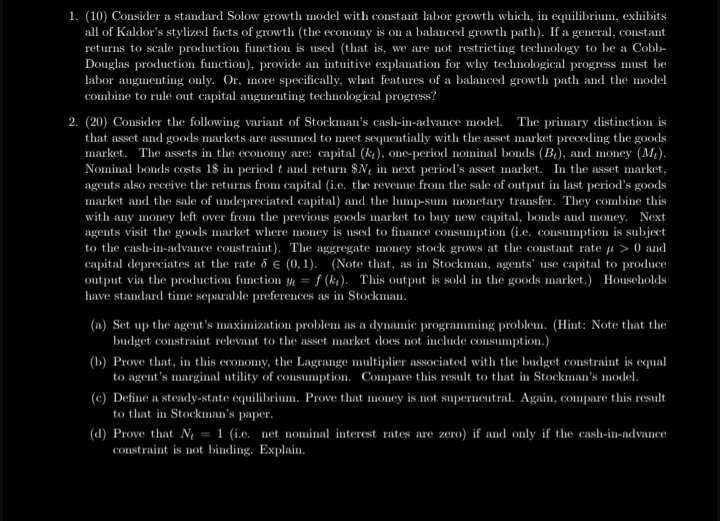


solve the following economics question
thankyou
4. (20) Consider the standard growth model in discrete time. There is a large number of identical households normalized to 1. Each household wants to maximize life-time discounted utility U({}o) = Bu(a), BE (0, 1). Each household has an initial capital ko at time 0, and one unit of productive time in each period that can be devoted to work. Final output is produced using capital and labor, according to a CRS production function F. This technology is owned by firms (whose measure does not really matter because of the CRS assumption). Output can be consumed (c) or invested (i,). Households own the capital (so they make the investment decision), and they rent it out to firms. Let 6 6 (0, 1) denote the depreciation rate of capital. Households own the firms, i.e. they are claimants to the firms' profits, but these profits will be zero in equilibrium. The function u is twice continuously differentiable and bounded, with u'(c) > 0, u"(c) 0, f"(x) 1/2. One and two period bonds are traded. Both bonds cost one unit of consumption in period f and return Rl, and R27, respectively, upon maturity. The remaining asset, equity, sells at the price of and pays a dividend each period given by de = oy, where or E (0, 1). Households choose consumption and assets in order to maximize expected lifetime utility given by: E Given this environment, answer the following questions: (a) Express the household's maximization problem as a dynamic programming problem. (In setting up the budget constraint, assume that two-period bonds are sold after holding them for one period.) (b) Define a recursive competitive equilibrium. Be precise in identifying the elements in your definition. (c) Solve the economy as a social planner problem and derive the equilibrium policy functions for capital and consumption. (d) Characterize the behavior of one-period interest rates in equilibrium. Explain your result. (e) Compare the average return from selling a two-period bond after holding it for one period to that from holding a one-period bond to maturity. Explain. (f) Prove that, if de = c, then q = ki+1- Explain.1. (10) Consider a standard Solow growth model with constant labor growth which, in equilibrium, exhibits all of Kaldor's stylized facts of growth (the economy is on a balanced growth path). If a general, constant returns to scale production function is used (that is, we are not restricting technology to be a Cobb- Douglas production function), provide an intuitive explanation for why technological progress must be labor augmenting only. Or, more specifically, what features of a balanced growth path and the model combine to rule out capital augmenting technological progress? 2. (20) Consider the following variant of Stockman's cash-in-advance model. The primary distinction is that asset and goods markets are assumed to meet sequentially with the asset market preceding the goods market. The assets in the economy are: capital (), one-period nominal bonds (B;), and money (M). Nominal bonds costs 18 in period t and return $N, in next period's asset market. In the asset market, agents also receive the returns from capital (ie. the revenue from the sale of output in last period's goods market and the sale of undepreciated capital) and the lump-sum monetary transfer. They combine this with any money left over from the previous goods market to buy new capital, bonds and money. Next agents visit the goods market where money is used to finance consumption (i.e. consumption is subject to the cash-in-advance constraint). The aggregate money stock grows at the constant rate a > 0 and capital depreciates at the rate 5 e (0, 1). (Note that, as in Stockman, agents' use capital to produce output via the production function y = f (k). This output is sold in the goods market.) Households have standard time separable preferences as in Stockman. (a) Set up the agent's maximization problem as a dynamic programming problem. (Hint: Note that the budget constraint relevant to the asset market does not include consumption.) (b) Prove that, in this economy, the Lagrange multiplier associated with the budget constraint is equal to agent's marginal utility of consumption. Compare this result to that in Stockman's model. (c) Define a steady-state equilibrium. Prove that money is not superneutral. Again, compare this result to that in Stockman's paper. (d) Prove that Me = 1 (i.e. net nominal interest rates are zero) if and only if the cash-in-advance constraint is not binding. Explain












